What We’re Reading: May 19th
Special Issue: Legumes – From Food Security to Climate Change
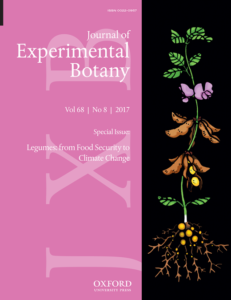 The April issue of J. Exp. Bot is a special issue on Legumes. The Editorial introduction, by Considine et al. (10.1093/jxb/erx099) observes that grain legumes “will form a cornerstone of future food and nutritional security and a global web of biodiversity.” Issue articles span topics including genomics resources and breeding tools, climate resiliency, interactions with soil microbes, and the potential for orphan or ancient crops to support food security. There is also a special Insight article by Stoddard, “Climate change can affect crop pollination in unexpected ways” that addresses how higher temperature affects pollinators and pollination. J. Exp. Bot. Tags: Applied Plant Biology, Botany, Genomics
The April issue of J. Exp. Bot is a special issue on Legumes. The Editorial introduction, by Considine et al. (10.1093/jxb/erx099) observes that grain legumes “will form a cornerstone of future food and nutritional security and a global web of biodiversity.” Issue articles span topics including genomics resources and breeding tools, climate resiliency, interactions with soil microbes, and the potential for orphan or ancient crops to support food security. There is also a special Insight article by Stoddard, “Climate change can affect crop pollination in unexpected ways” that addresses how higher temperature affects pollinators and pollination. J. Exp. Bot. Tags: Applied Plant Biology, Botany, Genomics
Review: Advances in methods for identification and characterization of plant transporter function ($)
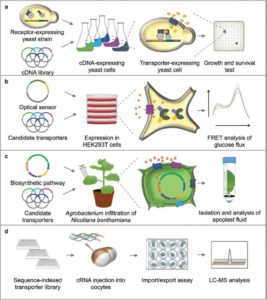 Transporters are massively important for the functions of a cell and organism, but also notoriously difficult to study. Larsen et al. review advances in the tools available for transporter research, ranging from expression in Xenopus oocytes to genetic screens using toxic analogues and fluorescent substrates, to in silico approaches. The authors provide examples of how these approaches have contributed insights into the SWEET family of sucrose transporters, as well as nitrate, boron and ABA transporters (and others), and future research directions. J. Exp. Bot. 10.1093/jxb/erx140 Tags: Biochemistry, Physiology, Transport
Transporters are massively important for the functions of a cell and organism, but also notoriously difficult to study. Larsen et al. review advances in the tools available for transporter research, ranging from expression in Xenopus oocytes to genetic screens using toxic analogues and fluorescent substrates, to in silico approaches. The authors provide examples of how these approaches have contributed insights into the SWEET family of sucrose transporters, as well as nitrate, boron and ABA transporters (and others), and future research directions. J. Exp. Bot. 10.1093/jxb/erx140 Tags: Biochemistry, Physiology, Transport
Review: Chloroplast function and ion regulation in plants growing on saline soils: lessons from halophytes ($)
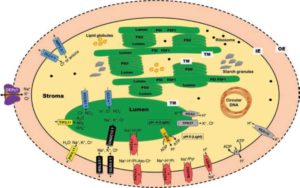 Salinity is a growing problem for food production. Progress has been made in understanding how plants tolerate salinity, mostly focused on strategies for tolerance at the plasma membrane and cytosol. Bose et al. review studies that focus on how the chloroplast is affected by salinity. The authors review the roles of Na+, Cl− and K+ in chloroplast function, and compare salinity responses of chloroplasts from halophytes (salt-tolerant plants) and glycophytes (non-tolerant plants). Although much is still unknown, there is compelling evidence to suggest that chloroplasts of halophytes are uniquely suited for a high-salt environment; “Halophyte chloroplasts may have intrinsically higher levels of oxidative protection, more stable photosynthetic apparatus, and/or better control over chloroplast membrane transport.” Clearly, these findings will be critical for efforts to engineer salt tolerance into crop plants. J. Exp. Bot. 10.1093/jxb/erx142 Tags: Abiotic Interactions, Ecophysiology, Physiology, Transport
Salinity is a growing problem for food production. Progress has been made in understanding how plants tolerate salinity, mostly focused on strategies for tolerance at the plasma membrane and cytosol. Bose et al. review studies that focus on how the chloroplast is affected by salinity. The authors review the roles of Na+, Cl− and K+ in chloroplast function, and compare salinity responses of chloroplasts from halophytes (salt-tolerant plants) and glycophytes (non-tolerant plants). Although much is still unknown, there is compelling evidence to suggest that chloroplasts of halophytes are uniquely suited for a high-salt environment; “Halophyte chloroplasts may have intrinsically higher levels of oxidative protection, more stable photosynthetic apparatus, and/or better control over chloroplast membrane transport.” Clearly, these findings will be critical for efforts to engineer salt tolerance into crop plants. J. Exp. Bot. 10.1093/jxb/erx142 Tags: Abiotic Interactions, Ecophysiology, Physiology, Transport
Review: Communication in the phytobiome ($)
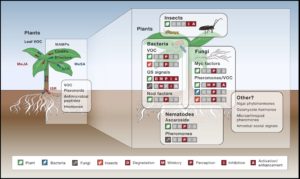 An old ad stated, “Without chemicals, life itself would be impossible,” but it’s only more recently that we’ve begun to understand the importance of semiochemicals – chemicals produced for communication. Leach et al. pull together insights from chemical ecologists, soil scientists, plant pathologists and entomologists in this excellent review of the phytobiome (all the living organisms in and around a plant) and the communication within it. They start by estimating the number and diversity of organisms (viruses, bacteria, fungi, arthropods, nematodes, protists and earthworms) that live together in the phytobiome, and then what we understand about their chemical signals. The authors conclude, “The nascent field of phytobiomes research is an attempt to strengthen the connections between ecological and agricultural bodies of knowledge for better translation to crop and managed ecosystems”, and direct readers to the Phytobiome Roadmap. Cell 10.1016/j.cell.2017.04.025 Tags: Applied Plant Biology, Biotic Interactions, Education and Outreach
An old ad stated, “Without chemicals, life itself would be impossible,” but it’s only more recently that we’ve begun to understand the importance of semiochemicals – chemicals produced for communication. Leach et al. pull together insights from chemical ecologists, soil scientists, plant pathologists and entomologists in this excellent review of the phytobiome (all the living organisms in and around a plant) and the communication within it. They start by estimating the number and diversity of organisms (viruses, bacteria, fungi, arthropods, nematodes, protists and earthworms) that live together in the phytobiome, and then what we understand about their chemical signals. The authors conclude, “The nascent field of phytobiomes research is an attempt to strengthen the connections between ecological and agricultural bodies of knowledge for better translation to crop and managed ecosystems”, and direct readers to the Phytobiome Roadmap. Cell 10.1016/j.cell.2017.04.025 Tags: Applied Plant Biology, Biotic Interactions, Education and Outreach
A nice cuppa genome: The tea (Camellia sinensis) genome
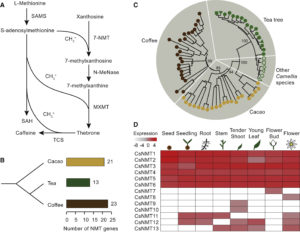 The release of the tea (Camellia sinensis) genome completes the set of the three major caffeine-producing plants (also coffee and cacao). (Note that the title of this article refers to the “tea tree”, a name that is often used for a different plant, Melaleuca alternifolia, the source of tea tree oil; the genome described here is of the tea beverage plant). Key findings include an expansion of genes involved in the synthesis of flavonoids that contribute to tea flavor. The data also show that caffeine synthesis evolved separately in tea as from coffee and cacao. Xia et al. point out that this is the first genome in the genus Camellia, which of course includes horticultural as well as oil-bearing species. Mol. Plant 10.1016/j.molp.2017.04.002 Tags: Genomics
The release of the tea (Camellia sinensis) genome completes the set of the three major caffeine-producing plants (also coffee and cacao). (Note that the title of this article refers to the “tea tree”, a name that is often used for a different plant, Melaleuca alternifolia, the source of tea tree oil; the genome described here is of the tea beverage plant). Key findings include an expansion of genes involved in the synthesis of flavonoids that contribute to tea flavor. The data also show that caffeine synthesis evolved separately in tea as from coffee and cacao. Xia et al. point out that this is the first genome in the genus Camellia, which of course includes horticultural as well as oil-bearing species. Mol. Plant 10.1016/j.molp.2017.04.002 Tags: Genomics
A TRIM insertion in the promoter of Ms2 causes male sterility in wheat
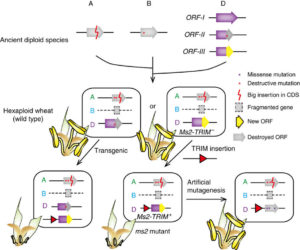 The first dominant male-sterile mutant in wheat, ms2 was identified more than 40 years ago, and Xia et al. have now identified the molecular basis for this trait. They find that the mutation is caused by a transposon (a terminal-repeat retrotransposon in miniature, or TRIM) insertion into the promoter of the Ms2 gene, causing it to be specifically expressed in anthers. The protein encoded by the Ms2 gene has no known functional domains, and only has homologues in the diploid ancestor of wheat, and tetraploid and hexaploid wheat, but functional analysis indicates that it is the cause of the male-sterile phenotype. The authors summarize, “The identification of Ms2 not only unravels the genetic basis of a historically important breeding trait, but also shows an example of how a TRIM element insertion near a gene can contribute to genetic novelty and phenotypic plasticity.” Nature Comms. 10.1038/ncomms15407 Tags: Genetics
The first dominant male-sterile mutant in wheat, ms2 was identified more than 40 years ago, and Xia et al. have now identified the molecular basis for this trait. They find that the mutation is caused by a transposon (a terminal-repeat retrotransposon in miniature, or TRIM) insertion into the promoter of the Ms2 gene, causing it to be specifically expressed in anthers. The protein encoded by the Ms2 gene has no known functional domains, and only has homologues in the diploid ancestor of wheat, and tetraploid and hexaploid wheat, but functional analysis indicates that it is the cause of the male-sterile phenotype. The authors summarize, “The identification of Ms2 not only unravels the genetic basis of a historically important breeding trait, but also shows an example of how a TRIM element insertion near a gene can contribute to genetic novelty and phenotypic plasticity.” Nature Comms. 10.1038/ncomms15407 Tags: Genetics
TOPLESS mediates brassinosteroid control of shoot boundaries and root meristem development in Arabidopsis thaliana
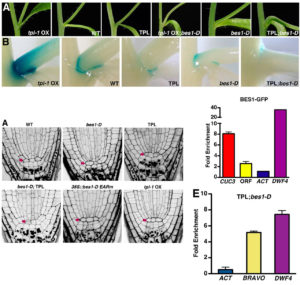 Shoot and root development in Arabidopsis thaliana are controlled by many factors, one of which is brassinosteroid (BR) signaling. BR-responsive gene expression is controlled by the BES1 and BZR1 transcription factors. Using its EAR domain, BES1 binds to the transcriptional repressor TOPLESS (TPL) to activate and repress genes. Espinosa-Ruiz et al. show genetic evidence for interaction between BES1 and TPL by using the bes1-D mutant that shows a constitutive BR response. Expression of the tpl-1 mutant reverses the bes1-D phenotype. CUP-SHAPED COTYLEDON (CUC) genes mark organ boundaries, and both TPL and BES1 repress CUC3 to separate organs. In the root quiescent center, cell division is tightly regulated. TPL binds with BES1 in the quiescent center to regulate the division repressor BRAVO. The BES1-TPL transcription regulation unit controls signals for cell proliferation in the root and shoot. (Summary by Daniel Czerny) Development 10.1242/dev.143214 Tags: Development, Signals and Responses
Shoot and root development in Arabidopsis thaliana are controlled by many factors, one of which is brassinosteroid (BR) signaling. BR-responsive gene expression is controlled by the BES1 and BZR1 transcription factors. Using its EAR domain, BES1 binds to the transcriptional repressor TOPLESS (TPL) to activate and repress genes. Espinosa-Ruiz et al. show genetic evidence for interaction between BES1 and TPL by using the bes1-D mutant that shows a constitutive BR response. Expression of the tpl-1 mutant reverses the bes1-D phenotype. CUP-SHAPED COTYLEDON (CUC) genes mark organ boundaries, and both TPL and BES1 repress CUC3 to separate organs. In the root quiescent center, cell division is tightly regulated. TPL binds with BES1 in the quiescent center to regulate the division repressor BRAVO. The BES1-TPL transcription regulation unit controls signals for cell proliferation in the root and shoot. (Summary by Daniel Czerny) Development 10.1242/dev.143214 Tags: Development, Signals and Responses
Discovery of nitrate–CPK–NLP signalling in central nutrient–growth networks ($)
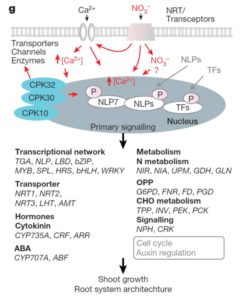 Nitrate acts as a potent signal as well as a source of nutritional nitrogen, but key players in the nitrate response have been missing from our understanding. Liu et al. identified a unique calcium signal stimulated by nitrate in mesophyll cells. They then found that in vitro kinase activity of Ca2+-sensor protein kinases (CPKs) are also nitrate stimulated, and they assayed constitutively-active Arabidopsis CPKs for stimulation of a nitrate-responsive reporter in response to nitrate. They found that several CPK genes act synergistically in the nitrate response. Efforts to generate higher-order CPK mutants were thwarted by embryo lethality, so the authors generated inducible mutants. The ipck mutant is a triple-inducible mutant of CPK10, CPK30 and CPK32. It shows significant defects in nitrate-responsive transcription and growth, and phosphorylation of NLP transcription factors. These results reveal a new Ca2+-CPK-NLP signaling cascade mediating nitrate responses. Nature 10.1038/nature22077 Tags: Gene Regulation, Genetics, Molecular Biology, Signals and Responses
Nitrate acts as a potent signal as well as a source of nutritional nitrogen, but key players in the nitrate response have been missing from our understanding. Liu et al. identified a unique calcium signal stimulated by nitrate in mesophyll cells. They then found that in vitro kinase activity of Ca2+-sensor protein kinases (CPKs) are also nitrate stimulated, and they assayed constitutively-active Arabidopsis CPKs for stimulation of a nitrate-responsive reporter in response to nitrate. They found that several CPK genes act synergistically in the nitrate response. Efforts to generate higher-order CPK mutants were thwarted by embryo lethality, so the authors generated inducible mutants. The ipck mutant is a triple-inducible mutant of CPK10, CPK30 and CPK32. It shows significant defects in nitrate-responsive transcription and growth, and phosphorylation of NLP transcription factors. These results reveal a new Ca2+-CPK-NLP signaling cascade mediating nitrate responses. Nature 10.1038/nature22077 Tags: Gene Regulation, Genetics, Molecular Biology, Signals and Responses
When pollinators are also herbivores ($)
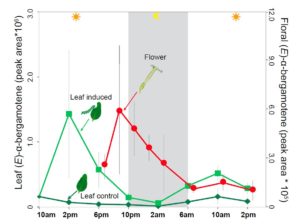 The interaction between wild tobacco (Nicotiana attenuata) and the moth Manduca sexta, which is both a pollinator and a herbivore, is a model for plant/ arthropod interactions and has revealed insights into chemical signals and defenses. Zhou et al. show that a single compound, the sesquiterpene (E)-α-bergamotene, serves as both a pollinator attractor when produced in flowers at night (when the adult moths pollinators are active), and when produced in leaves acts as an indirect defense signal by attracting predators, which eat the herbivorous larvae. Interestingly, a single gene that is under circadian control is responsible for the production of this compound in flowers and leaves. Curr. Biol. 10.1016/j.cub.2017.03.017 Tags: Biotic Interactions, Gene Regulation, Ecology
The interaction between wild tobacco (Nicotiana attenuata) and the moth Manduca sexta, which is both a pollinator and a herbivore, is a model for plant/ arthropod interactions and has revealed insights into chemical signals and defenses. Zhou et al. show that a single compound, the sesquiterpene (E)-α-bergamotene, serves as both a pollinator attractor when produced in flowers at night (when the adult moths pollinators are active), and when produced in leaves acts as an indirect defense signal by attracting predators, which eat the herbivorous larvae. Interestingly, a single gene that is under circadian control is responsible for the production of this compound in flowers and leaves. Curr. Biol. 10.1016/j.cub.2017.03.017 Tags: Biotic Interactions, Gene Regulation, Ecology
The highly buffered Arabidopsis immune signaling network conceals the functions of its components
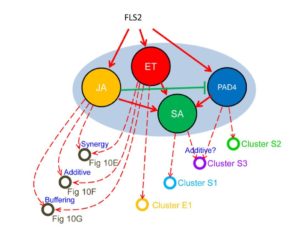
Classic genetic approaches have been instrumental in identifying genes that control developmental and defense networks, but as Hillmer et al. point out, analysis of single mutants is complicated by network buffering. They describe network buffering as occurring when the effect of losing a gene’s function is masked by the function of other genes. They point out that the immune signaling network must be highly buffered as it is constantly under attack by pathogens. Previously, they defined the immune network as being made up of four sub-networks, each of which can be interrupted by disabling a single gene. Specifically, they can eliminate the jasmonate, salicylate, ethylene and PAD4 sectors by elimination of a biosynthetic or signaling gene. They previously published an analysis of higher order mutants knocking out all combinations of these sub-networks. Here they analyze transcriptomic and hormone profiles of each of these mutants in response to flg22, a peptide that mimics the presence of a pathogen. Their results demonstrate that the immune network “is not a collection of independent pathways; rather interactions among the sectors dominate network regulation of the transcriptome response.” PLOS Genet. 10.1371/journal.pgen.1006639 Tags: Biotic Interactions, Computational Biology, Systems Biology
Fascination of Plants Day
Don’t forget to see how plant scientists have been celebrating plants around the world in honor of Fascination of Plants Day. More than 700 events in 50+ countries were scheduled to share plants and plant science information (many of the events occured on May 18th, the official FoPD, and others are taking place today and over this weekend). New this year is a social media wall that features all content tagged #BotanyLive, and features live-streamed videos of events and activities. It’s not too late to share your fascination of plants, just post on any social media site and add the tags #BotanyLive and #PlantDay!



Leave a Reply
Want to join the discussion?Feel free to contribute!